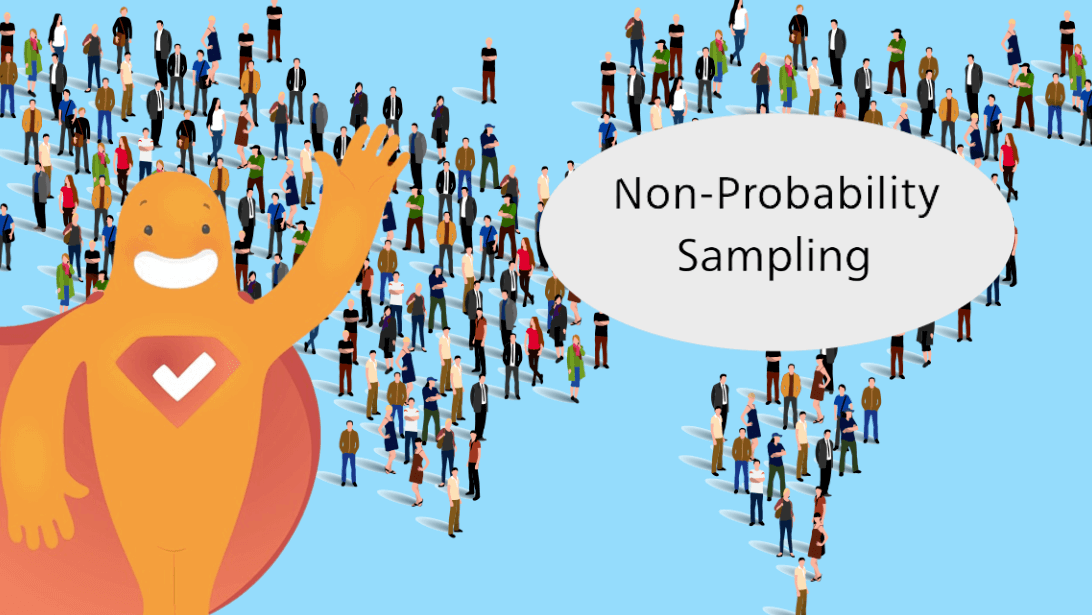Before any survey can begin, researchers need to consider how they will sample survey participants. Typically, it’s not possible or feasible to survey the entire population of a survey. Therefore, a researcher selects a subset of the larger population. Thankfully, there are a number of options at their disposal. One method is non-probability sampling. In this blog, we look at how it works, different types of non-probability sampling, how it differs from random sampling, and non-probability sampling advantages and disadvantages.
Create your FREE Non-Probability Survey, Poll, or Questionnaire now!
Non-Probability Sampling Definition
Non-probability sampling methods recognize that not everyone will have the chance to take a survey. This is the opposite of probability sampling, which aims to ensure that everyone in the population has an equal chance of receiving a survey.
To better understand the difference between non-probability sampling vs probability sampling, consider a store owner surveying his customers. He has a customer database of 5,000. Since he can’t survey them all, he decided to survey 10% of them. With probability sampling, which requires all customers to have an equal chance of participating, he uses a number generator (1 – 5,000) to select 500 customers at random that correspond with the numbers generated. Therefore, anyone from the population could have been selected, reducing potential survey bias.
With non-probability sampling, he doesn’t care that everyone has an equal chance of being chosen, he simply wants to survey 500 customers. So, he sends an online survey to the first 500 customers in his database. Or, he could survey each customer that comes into his store until he reaches 500. Either way, 4,500 people did not have the chance to receive a survey which can increase the chances of survey bias. We’ll discuss the pros and cons of this shortly.
Non-Probability Sampling Methods
As mentioned earlier, there are different ways to go about obtaining a non-probability sample. So, how many types of non-probability sampling are there? Generally, a researcher will select one of three non-probability sampling techniques.
1. Convenience Sampling
This is the quickest and easiest type of non-probability sampling. With convenience sampling, as the name implies, all that matters is convenience. This means the results are typically going to be less than scientific and therefore not applicable to the wider population. For example, a college student wants to learn about alcohol consumption among undergraduates, so she surveys people in her dorm because they’re easily accessible to her (i.e. convenient).
However, students in dorms are probably less likely to drink compared to those living off campus due to dorm rules, their age, and so on, so it’s not a representative sample. Her dorm may also be all female, leaving out all male students.
It’s important to note that there are two other subtypes of convenience sampling: Consecutive sampling, in which results are analyzed following each survey and the surveying continues until a conclusion can be reached, and self-selection, in which volunteers sign up to be part of the survey. Read more about convenience sampling.
2. Quota Sampling
Quota sampling is similar to convenience sampling in that anyone convenient to the researcher can be surveyed. The one difference is that there are specific targets for the number of people that need to be surveyed (e.g. 50 men and 50 women). So, using the student in an all-female dorm example, she could survey 50 girls in her dorm but would then need to go to a male dorm and survey 50 boys as well.
While this is still not the most scientific method, it at least gets a more diverse number of respondents from different subpopulations. Read more about quota sampling.
3. Purposeful Sampling
With the purposeful or purposive sampling method, the researcher uses their understanding of the survey’s purpose and their knowledge of the population to make a conscious decision on who should be included in the sample to serve the overarching goal. Then, the researcher selects the participants accordingly. He or she may opt to do this is a number of ways:
- Heterogeneity sampling, which aims to collect the widest range of opinions and perspectives on a given topic.
- Homogeneous sampling, which aims to collect opinions from like-minded participants (they may all be the same age, gender, race, religion, and so on).
- Deviant sampling, in which participants are selected based on an unusual or special trait.
- Expert sampling, in which specialists on a particular topic are sought out to inform the survey or validate the results of a previous survey.
4. Snowball Sampling
While this method is not common for a lot of surveys, snowball sampling is often put to use when a researcher needs to target specific groups that are hard to find or reach, or who may be hesitant to speak with them. Often, the topic is sensitive or personal, such as studies about illegal immigrants, drug users, or those with rare health conditions.
Therefore, researchers use a small pool of participants that they’ve found to “nominate,” through their social circle, others they know who fit the criteria. Often, incentives will be provided to the participants to entice them since they may not be forthcoming otherwise. Because topics are often sensitive, Simply Psychology states that researchers must take precautions to protect the privacy of potential subjects, keeping names anonymous and using online encryption techniques.
Advantages and Disadvantages of Non-Probability Sampling
Non-probability has both pros and cons. Here’s a rundown of both that researchers need to be aware of.
5 Pros of Non-Probability Sampling
- It’s a fast and inexpensive way to collect data. Little research is required prior to surveying as the researcher simply seeks out those easily within reach. If the researcher conducts non-probability sampling through an online platform, it becomes even easier as there are no geographical limits.
- It’s a great starting point in which to form quick hypotheses. Then, the researcher can determine if further probability sampling would be beneficial.
- Low response rates don’t factor in, as the researcher continues surveying until they’ve reached their desired sample size. Or, in the case of consecutive sampling, until they have enough data to reach a conclusion.
- It enables researchers to connect with under-represented or niche groups. This is usually accomplished through deviant sampling.
- Because these surveys can be conducted on a whim, opinions on current events and topics can be gathered in near real-time.
5 Cons of Non-Probability Sampling
- Participants receive surveys based on convenience or ease of access. This means there’s a high chance they may not be representative of the greater population. This undermines the validity of results.
- The researcher will likely be unable to calculate the margin of error. Margin or error in surveying refers to how much one can expect survey results to reflect the views from the total population.
- Samples may fill up with people who want to be part of research. This may be because they want the incentive or hold strong views that they want to share. This is common with self-selection sampling and snowball sampling methods.
- Samples sizes may be unclear because there is not a way to measure the boundaries of the relevant population in the study.
- Last but definitely not least, the biggest disadvantage is the potential for sampling bias. Because sample selection is deliberate, there is a big risk that a researcher’s personal views and opinions could easily influence the sample. For example, a researcher may only select people they feel comfortable with. Or, who fit within a particular demographic. Either way, this can greatly impact results.
Non-Probability Sampling with SurveyLegend Online Surveys
Online surveys are a great way to conduct non-probability sampling. As noted earlier, sure you can stand on a street corner or within a store and survey those who pass by or stop in. Or, you can cast a wider net by sending out online surveys. Since the “who” is not as important as the sample size, you can send out surveys to anyone – and as many as you like until you reach the desired sample size. If you do have some specifics, for example, needing a certain number of men or women, or a particular age group, you can qualify respondents with some eligibility questions based on demographics.
With SurveyLegend, our online surveys are easy to create and easy on the eyes. You can add pictures to surveys which boosts engagement, triggers memory, and crosses language barriers. Below is an example of one of our surveys with images. This has been designed to match the student drinking survey we highlighted at the start of this blog.
A few things you’ll note:
- The survey begins with a welcome page describing the goal of the survey and includes a survey image.
- The first demographic question includes a qualifier. This way the researcher will know when he or she has collected enough of each type of sample.
- Because gender identity can be a sensitive topic – but an important one particularly for today’s younger generations – multiple choices are offered along with a “prefer not to answer” option.
- If a participant selects that they don’t drink, the questionnaire uses survey logic to immediately take them to the thank you page.
- If a participant selects that they do drink, the survey continues with more questions.
- Various types of survey questions are used to engage participants: Multiple choice, sliding scale, thumb ratings, emojis, picture questions*, and an open-ended question.
Once again, this survey is live so try it out now. You can also refresh and retake it as many times as you like, as well as view live results.
Conclusion
Non-probability sampling is a quick and easy way to collect data. While there are multiple types of non-probability sampling, they all have one thing in common: They are not random. So, despite the ease of conducting them, there is the potential for survey bias. It’s up to each researcher to weigh the pros and cons of non-probability sampling. Then, it’s time to determine whether it’s the right method for the study. Whether you choose this type of sampling or another technique, SurveyLegend has you covered. We let you start for free, and have dozens of beautiful and responsive online survey templates from which to choose.
Do you use non-probability sampling when surveying? What do you feel are the biggest pros and cons of this method? Let us know in the comments!
Create your FREE Non-Probability Survey, Poll, or Questionnaire now!
Frequently Asked Questions (FAQs)
Non-probability sampling is a quick, easy, and inexpensive way to survey a subset of a larger population. To collect data, a subjective (or non-random) method is used.
There are four main methods of non-probability sampling with some subtypes. They are convenience sampling (with subsets consecutive and self-selection sampling); quota sampling; purposeful sampling (with subsets heterogeneous, homogeneous, deviant, and expert sampling); and snowball sampling. Read more about all types of survey sampling methods.
Because the participants are not surveyed completely at random, with some selection criteria determined by the researcher, there can be the risk of survey bias. Because of this, non-probability sampling is often used for non-scientific or fun surveys, or as a starting point before diving deeper with probability sampling.




